Tropospheric scatter
Tropospheric scatter (also known as troposcatter) is a method of communicating with microwave radio signals over considerable distances – often up to 300 kilometres (190 mi), and further depending on terrain and climate factors. This method of propagation uses the tropospheric scatter phenomenon, where radio waves at UHF and SHF frequencies are randomly scattered as they pass through the upper layers of the troposphere. Radio signals are transmitted in a narrow beam aimed just above the horizon in the direction of the receiver station. As the signals pass through the troposphere, some of the energy is scattered back toward the Earth, allowing the receiver station to pick up the signal.[1]
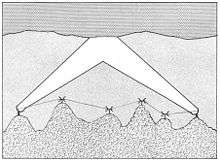
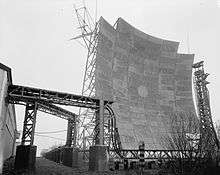
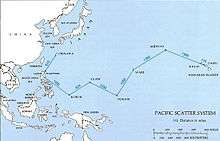
Normally, signals in the microwave frequency range travel in straight lines, and so are limited to line of sight applications, in which the receiver can be 'seen' by the transmitter. Communication distances are limited by the visual horizon to around 30–40 miles (48–64 km). Troposcatter allows microwave communication beyond the horizon. It was developed in the 1950s and used for military communications until communications satellites largely replaced it in the 1970s.
Because the troposphere is turbulent and has a high proportion of moisture the tropospheric scatter radio signals are refracted and consequently only a tiny proportion of the radio energy is collected by the receiving antennas. Frequencies of transmission around 2 GHz are best suited for tropospheric scatter systems as at this frequency the wavelength of the signal interacts well with the moist, turbulent areas of the troposphere, improving signal to noise ratios.
Overview
Historically, high gain dish or billboard antennas were required for tropospheric scatter systems as the propagation losses are very high; only about one trillionth (1 x 10−12) of the transmit power is available at the receiver. Paths were established at distances over 1,000 km. They required antennas ranging from 9 meters to 36 meters and amplifiers ranging from 1 kW to 50 kW. These were analogue systems which were capable of transmitting a few voice channels.
Troposcatter systems have evolved over the years. With communication satellites used for long-distance communication links, current troposcatter systems are employed over shorter distances than previous systems, use smaller antennas and amplifiers, and have much higher bandwidth capabilities. Typical distances are between 50 km and 250 km, though greater distances can be achieved depending on the climate, terrain, and data rate required. Typical antenna sizes range from 1.2 meters to 12 meters while typical amplifier sizes range from 10W to 2 kW. Data rates over 20Mbit/s can be achieved with today's technology.
Tropospheric scatter is a fairly secure method of propagation as dish alignment is critical, making it extremely difficult to intercept the signals, especially if transmitted across open water, making them highly attractive to military users. Military systems have tended to be ‘thin-line’ tropo – so called because only a narrow bandwidth ‘information’ channel was carried on the tropo system; generally up to 32 analogue (4 kHz bandwidth) channels. Modern military systems are "wideband" as they operate 4-16 Mbit/s digital data channels.
Civilian troposcatter systems, such as the British Telecom (BT) North Sea oil communications network, required higher capacity ‘information’ channels than were available using HF (high frequency – 3 to 30 MHz) radio signals, before satellite technology was available. The BT systems, based at Scousburgh in the Shetland Islands, Mormond Hill in Aberdeenshire and Row Brow near Scarborough, were capable of transmitting and receiving 156 analogue (4 kHz bandwidth) channels of data and telephony to / from North Sea oil production platforms, using frequency-division multiplexing (FDMX) to combine the channels.
Because of the nature of the turbulence in the troposphere, quadruple diversity propagation paths were used to ensure 99.98% reliability of the service, equating to about 3 minutes of downtime due to propagation drop out per month. The quadruple space and polarisation diversity systems needed two separate dish antennae (spaced several metres apart) and two differently polarised feed horns – one using vertical polarisation, the other using horizontal polarisation. This ensured that at least one signal path was open at any one time. The signals from the four different paths were recombined in the receiver where a phase corrector removed the phase differences of each signal. Phase differences were caused by the different path lengths of each signal from transmitter to receiver. Once phase corrected, the four signals could be combined additively.

Tropospheric scatter communications networks
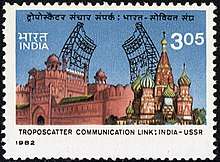
The tropospheric scatter phenomenon has been used to build both civilian and military communication links in a number of parts of the world, including:
- ACE High
- NATO military comms.link throughout Europe from the Norwegian-Soviet border to the Turkish-Soviet border.
- BT (British Telecom)
- United Kingdom - Shetland to Mormond Hill
- Germany
- Torfhaus-Berlin, Clenze-Berlin at Cold War times
- Portugal Telecom
- Portugal - Serra de Nogueira to Artzamendi
- CNT (Canadian telecomms company)
- Tsiigehtchic to Galena Hill, Keno City
- Hay River - Port Radium - Lady Franklin Point
- Pittsboro (Chatham County), NC - Buckingham, VA - Charlottesville, VA - Leesburg, VA - Hagerstown, MD
- Texas Towers - Air defence radars.
- Texas Tower 2
- Georges Bank, in 56-foot (17 m) deep water, 110 miles (180 km) east of Cape Cod 41°44′N 67°47′W / 41.733°N 67.783°W / 41.733; -67.783, linked to North Truro, MA.
- Texas Tower 3
- Nantucket Shoals, in 80-foot (24 m) water, 100 miles (160 km) south-east of Rhode Island 40°45′N 69°19′W / 40.75°N 69.317°W / 40.75; -69.317, linked to Montauk AFB, Long Island, NY.
- Texas Tower 4
- Un-named Shoal (Unofficially: Old Shaky), in 185-foot (56 m) water, 84 miles (135 km) south-east of New York City 39°48′N 72°40′W (Destroyed, with 28 killed, during a storm on 15 January 1961), linked to Highlands, NJ mainland station.
- Texas Tower 1
- Cashes Ledge (Lat. 42° 53'N., Long. 68° 57'W., 36-foot depth), 100 miles east of New Hampshire, not built.
- Texas Tower 5
- Brown's Bank (Lat. 42° 47'N., Long. 65° 37'W., 84foot depth), 75 miles south of Nova Scotia, not built.
- Mid Canada Line
- A series of five stations (070, 060, 050, 415, 410) in Ontario and Quebec around the lower Hudson Bay.
- Pinetree Line, Pole Vault
- A series of fourteen stations providing communications for Eastern seaboard radar stations of the US/Canadian Pinetree line, running from N-31 Frobisher Bay, Baffin Island to St. John's, Newfoundland and Labrador.
- White Alice/DEW Line/DEW Training (Cold War era)
- A former military and civil communications network with eighty stations stretching up the western seaboard from Port Hardy, Vancouver Island north to Barter Island (BAR), west to Shemya, Alaska (SYA) in the Aleutian Islands (just a few hundred miles from the Soviet Union) and east across arctic Canada to Greenland. Note that not all station were troposcatter, but many were. It also included a training facility for White Alice/DEW line tropo-scatter network located between Pecatonica, Illinois to Streator, Illinois.
- DEW Line (Post Cold War era)
- Several tropo-scatter networks providing communications for the extensive air-defence radar chain in the far north of Canada and the US.
- NARS
- NATO air-defence network stretching from RAF Fylingdales, via Mormond Hill, UK, Sornfelli (Faroe Islands), Höfn, Iceland to Keflavik DYE-5, Rockville.
- ET-A, USAREUR
- A US Army network from RAF Fylingdales to a network in Germany and a single station in France (Maison Fort).
- 486L, MEDCOM
- A US Navy network covering the European coast of the Mediterranean Sea from San Pablo, Spain in the west to Adana AFB, Turkey in the East, with headquarters at Ringstead in Surrey, England.
Communications to British Forces Germany, running from Swingate in Kent to Lammersdorf in Germany.
- BARS
- A Warsaw Pact tropo-scatter network stretching from near Rostok in the DDR (Deutsches Demokratisches Republik), Czechoslovakia, Hungary, Poland, Byelorussia USSR, Ukraine USSR, Romania and Bulgaria.
- Indian Air Force
- Part of an Air Defence Network covering major air bases, radar installations and missile sites in Northern and central India. The network is being phased out to be replaced with more modern fiber optic based communication systems.[2]
- Peace Ruby, Spellout, Peace Net
- An air-defence network set up by the United States in Iran pre-revolution. Spellout built a radar and comms network in the north of Iran. Peace Ruby built another air-defence network in the south and Peace net integrated the two networks.
- Bahrain - UAE
- A tropo-scatter system linking Al Manamah, Bahrain to Dubai, United Arab Emirates.
- RAFO
- A tropo-scatter communications system providing military comms to the former SOAF - Sultan of Oman's Air Force, (now RAFO - Royal Air Force of Oman), across the Sultanate of Oman.
- RSAF
- A Royal Saudi Air Force tropo-scatter network linking major airbases and population centres in Saudi Arabia.
- BACK PORCH and IWCS
- Two networks run by the United States linking military bases in Thailand and South Vietnam.
- Phil - Tai - Oki
- A system linking the Philippines with Taiwan.
- Cable & Wireless Caribbean network
A troposcatter link was established by Cable & Wireless in 1960, linking Barbados with Port of Spain, Trinidad. The network was extended further south to Georgetown, Guyana in 1965.[3][4]
- Japanese Troposcatter Networks
- Two networks linking Japanese islands from North to South.
Tactical Troposcatter Communication systems
_%E2%80%94_%D0%92%D1%8B%D1%81%D1%82%D0%B0%D0%B2%D0%BA%D0%B0_Milex-2019_(%D0%9C%D0%B8%D0%BD%D1%81%D0%BA%2C_%D0%91%D0%B5%D0%BB%D0%B0%D1%80%D1%83%D1%81%D1%8C)_00010.jpg)
As well as the permanent networks detailed above, there have been many tactical transportable systems produced by several countries:-[5]
- Soviet / Russian Troposcatter Systems
- MNIRTI R-423-1 Brig-1/R-423-2A Brig-2A/R-423-1KF
- MNIRTI R-444 Eshelon / R-444-7,5 Eshelon D
- MNIRTI R-420 Atlet-D
- NIRTI R-417 Baget/R-417S Baget S
- NPP Radiosvyaz R-412 A/B/F/S TORF
- MNIRTI R-410/R-410-5,5/R-410-7,5 Atlet / Albatros
- MNIRTI R-408/R-408M Baklan
- People's Republic of China (PRoC), People's Liberation Army (PLA) Troposcatter Systems
- CETC TS-504 Troposcatter Communication System
- CETC TS-510/GS-510 Troposcatter Communication System
- Western Troposcatter Systems
- AN/TRC-97 Troposcatter Communication System
- AN/TRC-170 Tropospheric Scatter Microwave Radio Terminal[6]
- AN/GRC-201 Troposcatter Communication System
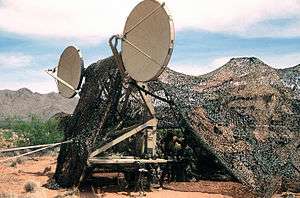
The U.S. Army and Air Force use tactical tropospheric scatter systems developed by Raytheon for long haul communications. The systems come in two configurations, the original "heavy tropo", and a newer "light tropo" configuration exist. The systems provide four multiplexed group channels and trunk encryption, and 16 or 32 local analog phone extensions. The U.S. Marine Corps also uses the same device, albeit an older version.
See also
- Radio propagation
- Non-line-of-sight propagation
- Microwave
- ACE High - Cold war era NATO European troposcatter network
- White Alice Communications System - Cold war era Alaskan tropospheric communications link
- List of White Alice Communications System sites
- TV-FM DX
- List of DEW Line Sites
- Distant Early Warning Line
References
External links
- FS-1037C definition of tropospheric scatter
- Russian tropospheric relay communication network
- Troposcatter communication network maps
- Jane's AN/TRC-170(v)
- Tropospheric Scatter Communications Systems Air Power Australia
- Tropospheric Scatter Communications - the essentials
- The short film STAFF FILM REPORT 66-19A (1966) is available for free download at the Internet Archive